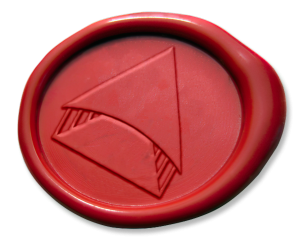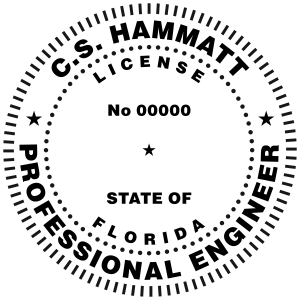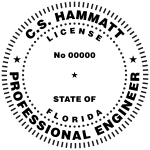
See Also: Sealing Tips and Tricks
Cutting through the confusion when a physical seal is not used. Read more…
Historically, the signing and sealing of a document was intended to verify its authenticity to its recipient.
Today, by signing, dating, and sealing an engineering document, a Professional Engineer:
- Verifies the authenticity of the document, and
- Accepts responsibility for its accuracy and legitimacy.
A Professional Engineer’s signature and seal allow agencies having jurisdiction to know who prepared the plans or reports, whom to contact with comments related to a submission, or whom to contact with questions or concerns. They also indicate that the document is a final engineering document. And, they place the responsibility for the document’s content on the PE who signed and sealed the document.
What Should Be Signed and Sealed?
As a Professional Engineer, you must sign, date, and seal all of your final plans, prints, specifications, reports, or other documents filed for public record or provided to the owner or the owner’s representative. Also, you may sign, date, and seal documents required by any public entity or any original document as required by contract.
You must not sign and seal any document that is not final unless you indicate any limitations on the document’s use by using terms such as “preliminary,” “for review only,” “not for construction,” or similar statements.”
Keep in mind that you can only sign and seal an engineering document that you were in responsible charge of preparing and had the engineering expertise required to produce the document. (See Rule 61G15-18.011(1), Florida Administrative Code, for details on responsible charge.)
See Rule 61G15-23.001, F.A.C. Signature, Date and Seal Shall Be Affixed.
Where Should Documents Be Signed and Sealed?
Where you sign and seal documents depends on the method you use to sign and seal.
When hand signing and sealing, every sheet of engineering design document must be signed, dated, and sealed by the Professional Engineer in responsible charge. A title block on each sheet must contain your printed name, address, and license number, and, if applicable, the qualified engineering business’s name and address. For engineering specifications and calculations, an index sheet should be signed, dated, and sealed by all PEs indicating the sections in which they are in responsible charge.
Digital or electronic signatures and seals are handled differently. When digitally signing and sealing, your digital signature and seal, with the date the document was sealed, should appear on the first page of the engineering document. When electronically signing and sealing, your electronic signature and seal, with the date the document was sealed, should appear on the signature report. With either of these methods, a title block should appear on each sheet of the document.
Methods of Signing and Sealing
A Professional Engineer may use a wet seal, an embossing seal, or a digital seal. Whichever is used must be at least 1-7/8 inches in diameter and similar in design as indicated in Rule 61G15-23.002, F.A.C., Seals Acceptable to the Board.
The method you choose for signing and sealing your engineering documents will depend on the format required by the public entity with which you are filing the documents. FBPE does not have jurisdiction over how engineering documents must be filed, as long as the public entity is not asking Professional Engineers to violate engineering laws and rules.
Physically Signing and Sealing
 Engineering documents can be hand signed with a pen, dated, and sealed by the Professional Engineer in responsible charge. The seal may be ink stamped, embossed, or a digital image, and placed partially overlapping — but not obscuring — your signature. The signature may not be a scanned, facsimile, digitally created, or copied image.
Engineering documents can be hand signed with a pen, dated, and sealed by the Professional Engineer in responsible charge. The seal may be ink stamped, embossed, or a digital image, and placed partially overlapping — but not obscuring — your signature. The signature may not be a scanned, facsimile, digitally created, or copied image.
Scanned or electronic copies of physically signed and sealed documents are not considered signed and sealed.
Digitally Signing and Sealing
A digital signature must be unique to the Professional Engineer using it, obtained from a third-party certification authority, and capable of verification. The certification authority will vet the PE and provide a password-protected digital signature file. (FBPE does not approve or provide a list of authorities.)
You may not use the digital signature option provided in Adobe Acrobat, since it is self-authenticated and does not use a third party. However, you may use Adobe Acrobat in conjunction with the digital signature provided by a proper certification authority.
Your digital signature must be linked to the document in such a way that any change invalidates the signature and document.
A digital signature is typically placed on the first page of an engineering document. A digitally signed and sealed document may include as many sheets as necessary. Each sheet must contain a title block.
While the formatting may be altered, the text located within the text box must remain identical to the examples, and must be placed on each of the electronic plan sheets but cannot be placed in the digital signature itself.
An example of a digitally created seal and the required text box language:

This item has been digitally signed and sealed by [NAME] on the date adjacent to the seal.
Signature must be verified on any electronic copies.
An example of the required text box language when a digitally created seal is not used:
[NAME], State of Florida, Professional Engineer, License No. [NUMBER]
This item has been digitally signed and sealed by [NAME] on the date indicated here.
Signature must be verified on any electronic copies.
When digitally signing and sealing specifications and calculations, you may use an index sheet. The statements in the example text boxes above are not required to be on every sheet of specifications and calculations, but must be included on the cover sheet.
Electronically Signing and Sealing
An electronic signature for a file of engineering documents is created by a piece of software called a secure hash standard (or SHA) authentication code generator.
The electronically signed and sealed file may include as many sheets as necessary. Each sheet must contain a title block.
After completing a project, you create a computer file that contains as many sheets as necessary for the engineering project. The file is run through the generator, which provides a string of numbers and letters (the SHA authentication code) that is used in your document’s signature report.
The printable signature report must include your name and license number, and list all items to which the electronic signature applies. The signature report must be printed and hand signed, dated, and sealed.
The signed and sealed report must be sent along with the electronically signed and sealed file either by hardcopy or electronic scan. (If the signature report is scanned and sent electronically, you must retain the hardcopy as required in Rule 61G15-30.009, F.A.C., Retention of Engineering Documents.)
Printed copies of electronically signed, dated, and sealed documents are not considered signed and sealed.
Simply encrypting, securing, or locking an electronic file does not constitute a digital or electronic signature or seal.
Please note that while the formatting may be altered, the text located within the text box must remain identical to the examples, and must be placed on the electronic plan sheets and not a part of the electronic signature itself.
An example of an electronically created seal and the required text box language:

This item has been electronically signed and sealed by [NAME] on the date adjacent to the seal using a SHA authentication code.
Printed copies of this document are not considered signed and sealed and the SHA authentication code must be verified on any electronic copies.
An example of the required text box language when an electronically created seal is not used:
[NAME], State of Florida, Professional Engineer, License No. [NUMBER]
This item has been electronically signed and sealed by [NAME] on the date indicated here using a SHA authentication code.
Printed copies of this document are not considered signed and sealed and the SHA authentication code must be verified on any electronic copies.
When electronically signing and sealing specifications and calculations, you may use an index sheet. The statements in the example text boxes above are not required to be on every sheet of the specifications and calculations, but must be included on the cover sheet.
See Rule 61G15‐23.005, F.A.C., Procedures for Electronically Signing and Sealing Electronically Transmitted Plans, Specifications, Reports or Other Documents.
Where Do I Purchase My Seal?
A web search will turn up a list of vendors of engineering seals.
The Board does not provide nor sell any types of seals, and cannot recommend vendors of seals.

